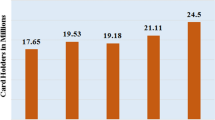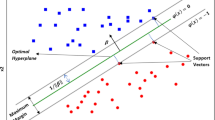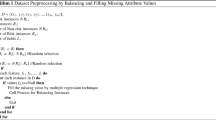Abstract
The recent financial tsunami and subprime crisis both triggered an excessive global financial decline. Since then, the ability to ensure the creditworthiness of firms, the development of a suitable credit rating mechanism and appropriate rating policies have become critical issues for most financial institutions. Credit rating is a multi-classification task. The decision-tree support vector machine (DTSVM) has been one of the most powerful models in dealing with multi-classification problems. However, the determination of important data features significantly affects the computation time and classification accuracy of DTSVM models. In addition, the inability to provide rules for decision-makers limits the practical applications of DTSVM models. This study proposes an M-DTSVM-RST model which integrates the unique strength of multiple feature selection strategies in feature determination, DTSVM in multi-classification, and rough set theory (RST) in rule generation. The advantages of the designed M-DTSVM-RST model include the ensemble learning ability in selecting essential attributes, the capability in yielding rules for decision-makers in multi-classification cases by the DTSVM technique with RST. Experimental results show that the M-DTSVM-RST model is a promising alternative in analyzing the credit rating problem.

Similar content being viewed by others
References
Abad, P., Robles, M.D.: Credit rating agencies and idiosyncratic risk: is there a linkage? Evidence from the Spanish market. Int. Rev. Econ. Finance 33, 152–171 (2014)
Barakat, N., Diederich, J.: Eclectic rule-extraction from support vector machines. Int. J. Comput. Intell. 2, 59–62 (2005)
Bose, I.: Deciding the financial health of dot-coms using rough sets. Inf. Manag. 43, 835–846 (2006)
Bottou, l., Cortes, C., Denker, J., Drucker, H., Guyon, I., Jackel, L., LeCun, Y., Muller, U., Sackinger, E., Simard, P., Vapnik, V.: Comparison of classifier methods: a case study in hand writing digit recognition. In: Proceedings of the 12th International Conference on Pattern Recognition, Jerusalem, pp. 77–82 (1994)
Capotorti, A., Barbanera, E.: Credit scoring analysis using a fuzzy probabilistic rough set model. Comput. Stat. Data Anal. 56, 981–994 (2012)
Chang, F., Guo, C.Y., Lin, X.R., Lu, C.J.: Tree decomposition for large-scale SVM Problems. J. Mach. Learn. Res. 11, 2935–2972 (2010)
Chang, F., Liu, C.C.: Solving large-scale multi-label SVM problems with a tree decomposition approach. In: The 3rd Asian Conference on Machine Learning, Taoyuan, pp. 1–16 (2011)
Chaudhuri, A., De, K.: Fuzzy support vector machine for bankruptcy prediction. Appl. Soft Comput. 11, 2472–2486 (2011)
Chen, Y.S., Cheng, C.H.: Hybrid models based on rough set classifiers for setting credit rating decision rules in the global banking industry. Knowl.-Based Syst. 39, 224–239 (2013)
Chen, C.C., Li, S.T.: Credit rating with a monotonicity-constrained support vector machine model. Expert Syst. Appl. 41, 7235–7247 (2014)
Cortes, C., Vapnik, V.: Support-vector network. Mach. Learn. 20, 273–297 (1995)
Deng, J.D., Simmermacher, C., Cranefield, S.: “A study on feature analysis for musical instrument classification”, IEEE Transactions on Systems, Man, and Cybernetics—Part B. Cybernetics 38, 429–438 (2008)
Fung, G., Sandilya, S., Rao, R.: Rule extraction from linear support vector machines. In: Proceedings of the Eleventh SIGKDD International Conference on Knowledge Discovery and Data Mining, Illinois, pp. 32–40 (2005)
Friedman, J.: Another approach to polychotomous classification. Technical Report, Stanford University (1996)
Hajek, P., Michalak, K.: Feature selection in corporate credit rating prediction. Knowl.-Based Syst. 51, 72–84 (2013)
Hanilçi, C., Ertaş, F.: Investigation of the effect of data duration and speaker gender on text-independent speaker recognition. Comput. Electr. Eng. 39, 441–452 (2013)
Hou, S., Ramani, K.: Classifier combination for sketch-based 3D part retrieval. Comput. Graph. 31, 598–609 (2007)
Hsu, M.F., Pai, P.F.: Incorporating support vector machines with multiple criteria decision making for financial crisis analysis. Qual. Quant. 47, 3481–3492 (2013)
Huang, C.C., Tseng, T.L., Fan, Y.N., Hsu, C.H.: Alternative rule induction methods based on incremental object using rough set theory. Appl. Soft Comput. 13, 372–389 (2013)
Huang, Z., Chen, H., Hsu, C.J., Chen, W.H., Wu, S.: Credit rating analysis with support vector machines and neural networks: a market comparative. Decis. Support Syst. 37, 543–558 (2004)
Hwang, R.C., Chung, H., Chu, C.K.: Predicting issuer credit ratings using a semiparametric method. J. Empir. Finance 17, 120–137 (2010)
Jia, J., Yang, N., Zhang, C., Yue, A., Yang, J., Zhu, D.: Object-oriented feature selection of high spatial resolution images using an improved Relief algorithm. Math. Comput. Model. 58, 619–626 (2013)
Joachims, T.: Making large-scale support vector machine learning practical. In: Schlkopf, B., Burges, C.J., Smola, A.J. (eds.) Advances in Kernel Methods—Support Vector Learning, pp. 169–184. MIT Press, Cambridge (1999)
Kabir, MdM, Islam, MdM, Murase, K.: A new wrapper feature selection approach using neural network. Neurocomputing 73, 3273–3283 (2010)
Klautau, A., Jevtic, N., Orlitsky, A.: On nearest-neighbor error-correcting output codes with application to all-pairs multiclass support vector machines. J. Mach. Learn. Res. 4, 1–15 (2003)
Kim, H.S., Sohn, S.Y.: Support vector machines for default prediction of SMEs based on technology. Eur. J. Oper. Res. 201, 838–846 (2010)
Kim, K., Ahn, H.: A corporate credit rating model using multi-class support vector machines with an ordinal pairwise partitioning approach. Comput. Oper. Res. 39, 1800–1811 (2012)
Kreßel, U.: Pairwise classification and support vector machines. In: Schölkopf, B., Burges, C.I., Smola, A.J. (eds.) Advances in Kernel Methods—Support Vector Learning, pp. 255–268. MIT Press, Cambridge (1999)
Kullback, S.: An application of information theory to multivariate analysis. Ann. Math. Stat. 23, 88–102 (1952)
Kumar, M.A., Gopal, M.: A comparison study on multiple binary-class SVM methods for unilabel text categorization. Pattern Recogn. Lett. 31, 1437–1444 (2010)
Liou, J.H., Tzeng, G.H.: A Dominance-based Rough Set Approach to customer behavior in the airline market. Inf. Sci. 180, 2230–2238 (2010)
Li, F., Yin, Y., Lu, L.: (ϑ, T)-fuzzy rough approximation operators and the TL-fuzzy rough ideals on a ring. Inf. Sci. 177, 4711–4726 (2007)
Lin, K.P., Pai, P.F., Lu, Y.M., Chang, P.T.: Revenue forecasting using a least-squares support vector regression model in a fuzzy environment. Inf. Sci. 220, 196–209 (2013)
Li, C.F., Yin, J.Y.: Variational Bayesian independent component analysis-support vector machine for remote sensing classification. Comput. Electr. Eng. 39, 717–726 (2013)
Martens, D., Baesens, B., Gestel, T.V.: De-compositional rule extraction from support vector machines by active learning. IEEE Trans. Knowl. Data Eng. 21, 178–191 (2009)
Nguyen, H.S., Nguyen, S.H.: Analysis of Stulong data by rough set exploration system (RSES). In: The 14th European Conference on Machine Learning (ECML) and the 7th European Conference on Principles and Practice of Knowledge Discovery in Databases, Cavtat, pp. 71–82 (2003)
Öğüt, H., Doğanay, M.M., Ceylan, N.B., Aktaş, R.: Prediction of bank financial strength ratings: the case of Turkey. Econ. Model. 29, 632–640 (2012)
Pawlak, Z.: Rough sets. Int. J. Inf. Comput. Sci. 11, 341–356 (1982)
Paleologo, G., Elisseeff, A., Antonini, G.: Subagging for credit scoring models. Eur. J. Oper. Res. 201, 490–499 (2010)
Peng, Y., Wang, G., Kou, G., Shi, Y.: An empirical study of classification algorithm evaluation for financial risk prediction. Appl. Soft Comput. 11, 2906–2915 (2011)
Platt, J.C., Cristianini, N., Shawe-Taylor, J.: Large margin DAGs for multiclass classification. In: Jordan, M., Keams, M., SoJla, S. (eds.) Advances in Neural Information Processing Systems, vol. 12, pp. 547–553. MIT Press, Cambridge (2000)
Platt, J.C.: Fast training of support vector machines using sequential minimal optimization. In: Schlkopf, B., Burges, C.J., Smola, A.J. (eds.) Advances in Kernel Methods—Support Vector Learning, pp. 169–184. MIT Press, Cambridge (1998)
Pudil, P., Novovicova, J., Kittler, J.: Floating search methods in feature selection. Pattern Recogn. Lett. 15, 1119–1125 (1994)
Qian, H., Mao, Y., Xiang, W., Wang, Z.: Recognition of human activities using SVM multi-class classifier. Pattern Recognit. Lett. 31, 100–111 (2010)
Ren, J.: ANN vs. SVM: which one performs better in classification of MCCs in mammogram imaging. Knowl.-Based Syst. 26, 144–153 (2012)
Scherbart, A., Nattkemper, T.W.: Looking inside self-organizing map ensembles with resampling and negative correlation learning. Neural. Netw. 24, 130–141 (2011)
Sun, J., Li, H.: Financial distress prediction using support vector machines: ensemble vs. individual. Appl. Soft Comput. 12, 2254–2265 (2012)
Smyth, P., Goodman, R.M.: Rule induction using information theory. In: Piatetsky-Shapiro, G., Frawley, W. (eds.) Knowledge Discovery in Databases, pp. 169–184. MIT Press, Cambridge (1991)
Tsai, C.F., Hsiao, Y.C.: Combining multiple feature selection methods for stock prediction: union, intersection, and multi-intersection approaches. Decis. Support Syst. 50, 258–269 (2010)
Uğuz, H.: A hybrid system based on information gain and principal component analysis for the classification of transcranial Doppler signals. Comput. Methods Programs Biomed. 107, 598–609 (2012)
Vapnik, V.: The Nature of Statistical Learning Theory. Springer Verlag, New York (1995)
Vieira, S.M., Sousa, J.M.C., Kaymak, U.: Fuzzy criteria for feature selection. Fuzzy Sets Syst. 189, 1–18 (2012)
Wang, G., Ma, J.: A hybrid ensemble approach for enterprise credit risk assessment based on Support Vector Machine. Expert Syst. Appl. 39, 5325–5331 (2012)
Wang, G., Hao, J., Ma, J., Jiang, H.: A comparative assessment of ensemble learning for credit scoring. Expert Syst. Appl. 38, 223–230 (2011)
Whitney, A.: A direct method of nonparametric measurement selection. IEEE Trans. Comput. 20, 1100–1103 (1971)
Witlox, F., Tindemans, H.: The application of rough sets analysis in activity-based modelling, opportunities and constraints. Expert Syst. Appl. 27, 585–592 (2004)
Wang, A., Yuan, W., Liu, J., Yu, Z., Li, H.: A novel pattern recognition algorithm: combining ART network with SVM to reconstruct a multi-class classifier. Comput. Math Appl. 57, 1908–1914 (2009)
Xia, H.: Can investor-paid credit rating agencies improve the information quality of issuer-paid rating agencies? J. Financ. Econ. 111, 450–468 (2014)
Xie, J., Wang, C.: Using support vector machines with a novel hybrid feature selection method for diagnosis of erythemato-squamous diseases. Expert Syst. Appl. 38, 5809–5815 (2011)
Yap, B.W., Ong, S.H., Husain, N.H.M.: Using data mining to improve assessment of credit worthiness via credit scoring models. Expert Syst. Appl. 38, 13274–13283 (2011)
Zhong, H., Miao, C., Shen, Z., Feng, Y.: Comparing the learning effectiveness of BP, ELM, I-ELM, and SVM for corporate credit ratings. Neurocomputing 128, 285–295 (2014)
Zhu, P., Hu, Q.: Rule extraction from support vector machines based on consistent region covering reduction. Knowl.-Based Syst. 42, 1–8 (2013)
Zhu, D., Premkumar, G., Zhang, X., Chu, C.H.: Data mining for network intrusion detection: a comparison of alternative methods. Decis. Sci. 32, 1–26 (2001)
Acknowledgments
The authors would like to thank Ministry of Science and Technology of the Republic of China, Taiwan, for financially supporting this research under Contract Numbers NSC 101-2410-H-260-005-MY2 and MOST 103-2410-H-260-020.
Author information
Authors and Affiliations
Corresponding author
Rights and permissions
About this article
Cite this article
Pai, PF., Tan, YS. & Hsu, MF. Credit Rating Analysis by the Decision-Tree Support Vector Machine with Ensemble Strategies. Int. J. Fuzzy Syst. 17, 521–530 (2015). https://doi.org/10.1007/s40815-015-0063-y
Received:
Revised:
Accepted:
Published:
Issue Date:
DOI: https://doi.org/10.1007/s40815-015-0063-y




